Friday Nov 28, 2025
Friday Nov 28, 2025
Saturday, 25 August 2018 00:10 - - {{hitsCtrl.values.hits}}

ESPNCricinfo: Chandika Hathurusingha cut short his stint as head coach of the Bangladesh cricket team last year, in order to take up the head coach position in his native Sri Lanka. At the end of his first seven months in the job, ESPNcricinfo talks to him about his plans for the team, and rebuilding after a woeful 2017. Following are excerpts:
Q: This isn’t your first stint with the Sri Lanka team – you were part of the set-up a few years ago, in the late 2000s. Any major surprises this time around?
A: The thing I know is the difference in the cricket intelligence of the two teams I worked with. The previous one has a lot of experience, and had a lot of cricketers that were very good students of the game. When I came back this time, the cricket intelligence was there, but it was not at that level.
Q: How did your years in Australia and as head coach of Bangladesh change you as a coach?
A: Every job is a new experience. When I went to Australia, I got really good exposure to coaching with New South Wales cricket. And then there was a little bit of coaching with Cricket Australia as well. Handling Sydney Thunder was another big experience. Bangladesh was a different challenge. Every team has different dynamics and different maturity. Your approach has to change accordingly.
In Australia the biggest thing is team culture – they are very big on that. They are big on consistently working towards a plan, at a more advanced level than many other countries. They are patient about waiting for those plans to work. They don’t take hasty decisions quickly. Those are the positives from the Australia experience.
In Bangladesh I got confidence in doing things that I trust – trust in my instincts. I got a lot of support from the board.
Q: Through your years in Bangladesh, there were suggestions that you were a bit of a micromanager. Is that fair to say?
A: (Laughs) I don’t think so. With coaching comes responsibility. You have to take it on yourself without passing it on to someone else. When things are going well or if they are going badly, I believe that as a leader you have to stand up for your people. I don’t think I’m a micromanager. I give a lot of freedom to players and to staff in the team. I don’t have much time for people who don’t know what they are doing.
Q: Sri Lanka have come out of a period of inconsistent selections. How did that affect the player pool and how you have to approach your job?
A: It brings a lot of insecurity. Continuous changes don’t help anybody – not the decision-makers, and not the players. When decision-makers change what they do quickly, that means they don’t have conviction in what they were doing. There’s also no stability among the players. Once you identify your players’ strengths, you need to give them enough time to fulfil that potential. For me, the key thing is to keep the dressing room calm, and give them space to go and perform to the best of their ability. I think that’s what I did in Bangladesh as well. We played with about 20-odd players in four years.
Q: Has that period of instability set Sri Lanka back?
A: Yes. Players were playing with what I call yesterday’s mindset. They were worried about what happened in the past rather than what’s happening today. All that comes with uncertainty over their roles.
Q: For a long time there was a theory that a local shouldn’t coach Sri Lanka, because they would be too susceptible to the political wrangling that goes on. How do you manage that side of things?
A: That’s not my opinion, so I don’t want to comment. That’s for people to change their minds after I go.
Q: But is there an amount of wrangling that you have to do with administrators?
A: I think it comes with the subcontinent. It’s a different dynamic. There are a lot of people with opinions. Having worked in Australia, Bangladesh and here, that’s a cultural difference that I see. I expected that. But at the same time if you’re taking on a challenge, you should be able to handle it.
Q: Has your experience in Bangladesh helped you deal with it?
A: I think so. Not only my experience with Bangladesh but my experience with Sri Lanka Cricket in the past as well is helping. I don’t micromanage, but I do what I think is right, without worrying about other people.
Q: How important is freedom within the team?
A: Very important. I think that’s the key in any team sport. There is enough pressure in the middle. They should be able to make decisions without fear of consequences. That’s what I mean by freedom. I’ve been surprised by the speed of the results when we brought that freedom - how quickly some individuals thrived in this environment. A good example is Thisara Perera. There are so many other guys.
Q: You’ve talked about Pep Guardiola being someone you admire. What have you taken from his career?
A: The thing is, he believes in his style, and he’s not afraid to take that style to every team he coaches. It’s an open style of play. It’s interesting to keep an eye on – someone doing it at such a high level.
Q: How would you describe the style of play you advocate?
A: Personally I won’t stick to one model. It depends on the team that you coach, and the team’s maturity. The challenge for the coach is to identify the strength and limitations of that team, and to maximise the potential. I’m not afraid to change things if they are not working. I’m not a coach that says: “This is how we’re always going to play.”

Q: What kind of potential do you see in this team? What would you like to see them achieve over the next 10 years?
A: The Test team is doing well, though our challenge is to do well away from home. The limited-overs team has huge potential. If you see in the last three games of the ODI series against South Africa, we changed our way of playing, and we nearly scored 300 three times. Not many teams can change the strategy suddenly and do so well in a short period of time.
This team is so talented, the potential has excited me. If we can get our bowling plans right and the players believing in the potential they have in different conditions, we can be very exciting.
Q: There has been a spotlight on the fitness of the Sri Lanka team over the past 18 months – some members of this team aren’t as trim as many other cricketers from around the world. Is that an issue?
A: I think Sri Lanka Cricket has done a good job in that sense. When I came here, players were a lot fitter and a lot more aware of nutrition and what needs to be done to play cricket. In terms of appearance, slimmer doesn’t mean you are fit. For me, if you are fit enough to perform your role and continue to do that in a busy schedule – that is fitness. We need to be careful about the nutrition part because of the nature of our diet. This group of players is much more savvy in that area.
Q: The Asia Cup is coming up in less than two months. What are you hoping to achieve there?
A: Asia Cup is a different challenge from the World Cup, and we need to win. Tactically we might do one or two things differently on those pitches. We might not play the way we have been playing in bilateral series. It’s going to be mix-and-match in terms of team composition.
Q: By mix-and-match do you mean you’ll select teams on the basis of conditions from match to match?
A: Yes, based on conditions, the opposition and our strength.
Q: Compared to India and Pakistan, it seems like Sri Lanka are quite far off the pace in ODIs. What do they have to do to catch up?
A: You are talking about history. I can’t be part of history – I started only seven months ago. The series against South Africa was only my second ODI assignment. The first was the tri-series in Bangladesh, which we won [the third team was Zimbabwe]. There, we mixed and matched to the opposition, and we played to the conditions. In this South Africa series, we were keeping one eye on the World Cup, and we changed the way we wanted to play after two games. So it’s a very early stage for me to comment on that. The positive thing is that we know what we are doing and we know where we want to go.
Q: There’s a big southern hemisphere summer coming up, after a big home series against England. Are you worried about injuries?
A: Yes, I’m concerned. We have very good medical staff with us. They are guiding us and educating our players. It’s a big challenge for us – especially to keep the best fast bowlers on the park. We have to rotate players – that’s one thing we can do. But still we want to be competitive. We have to keep one eye on the World Cup, because that’s the biggest prize in limited-overs cricket.
Q: Fast bowlers will be key on those away tours, but even though you have some young quicks, there is a possibility that because of the spin-friendly nature of pitches at home, they won’t play Tests until Sri Lanka play away again. How do you tackle that challenge?
A: That’s all to do with the planning and what you do away from the arena – how you train, and how many overs you bowl at training. We have a very good plan in place to keep their workload up, so that when it comes to the Tests overseas, they are ready to bowl at Test-match intensity. Unfortunately they won’t get pitches conducive for fast bowling in Sri Lanka – though that won’t be the case in every series, and it will depend on the opposition we play.
Q: Does playing on turning Test tracks at home undermine Sri Lanka’s ability to win overseas?
Why would you worry? If you are winning at home, when you go overseas you can prepare for those conditions.
A: A lot of teams do feel as if they prepare for foreign conditions, and yet they lose…
Can I ask you a question? Tell me a team that has been successful overseas. Having all these resources, which team has been successful? Australia went to India and lost three-nil [Australia lost 2-1 to India in 2016-17]. It’s not an easy science, to be successful like that.
Q: How can Sri Lanka break that trend?
A: We have to have resources, by which I mean players. If your system doesn’t produce players, you can’t perform magic. South Africa can’t do three weeks of sessions and train themselves to play on certain conditions – it’s not easy. And when subcontinent teams go and play away, it’s not easy. But we did something that not many Asian teams have done: winning in Barbados. After so many years, no Asian team has won a match. So don’t underestimate Sri Lanka.
Q: In Bangladesh you oversaw the rise of a good group of fast bowlers. Is there a blueprint from that experience that you can apply in Sri Lanka?
A: Yes, we have done that. We have already started. We’ve identified a pool of seven or eight fast bowlers, and below that we’ve looked at the longer-term prospects as well. They’ve been working systematically, getting their core strength, nutrition and skillsets developed. You will see when we go away from home, if everybody is fit to select, we will have a very good fast-bowling unit.
Q: What does that process of developing quicks here look like?
A: You have to identify the fast bowlers at a young age, and you have to give them a proper bowling schedule, with a proper plan. It’s not a three-month plan. Get them fitter and stronger and get them aware of their nutrition, and then give them a skillset.
The easiest thing in cricket is to identify fast bowlers. If you can bowl fast at a young age, you are a fast bowler. It’s a no-brainer. What happens around the world with almost any team is that when you are a fast bowler at a young age, you play a lot of cricket, because you are the man who is winning matches. But people don’t realise they are getting injured when they are young. When you are young and trying to bowl 135-140kph, it’s not easy. We have to identify early and put them in a good system. Our high-performance system is doing that. We will get the benefit in time to come.
Q: On the batting front, what needs to happen between now and those southern-hemisphere tours, so that they can be confident of facing down a Trent Boult or a Kagiso Rabada at home?
A: It’s about exposing batsmen to those conditions in training. We can create those kinds of conditions in our country. Just before the West Indies tour we went to Kandy and we had a training camp where we worked on specifics. We played with the Dukes ball, and we were competitive in the West Indies - we could have won the series. I’m impressed with Pallekele and how you can have different types of grass on the pitch and create different conditions. Creating that environment is the way forward for us.
Q: Looking ahead to the World Cup, does Sri Lanka have the batting firepower to be successful in England?
A: I believe we do have the firepower. How many teams can score 300 in 40 overs [as Sri Lanka did in the rain-curtailed fourth ODI against South Africa]? It’s a matter of having players in form and fit at the right time.
Q: Kusal Mendis has played some incredible innings, but there have been some patchy periods as well. How can he take the next step up in his career?
A: For any player to be consistent, you have to believe in something that you are doing, rather than changing based on what happened in the past. The key for every player is having belief in a method that’s working for you, not changing too much one series to another. You have to understand the challenges series to series and opposition to opposition. That comes with maturity and time. I think he’s a tremendous talent. At his age, go and check what Mahela and Sanga had done and compare.
Q: Dinesh Chandimal was quite an aggressive batsman when he first came on the scene, and has completely changed his game to being a conservative Test batsman. What are your thoughts about that journey?
A: When I came back to Sri Lanka, I asked him the same question. I asked him why he went in that direction. He has his reasons. Probably the challenge that he had was that he was the premier batsman in a continuously changing environment. You will see him coming back to his true potential in the coming months.
Q: Rangana Herath has said he will retire after the England series. Do you feel confident you have your bases covered in the spin department, or is there a lot of work to be done still?
A: I wouldn’t say there’s a lot of work. Replacing Rangana, one of your all-time best, is not easy. No team can do that. We have players. We have spinners that do a job, but not the same as Rangana. The challenge is there. People expect new Ranganas and Sangas and Muralis to come just as soon as they retire. They forget about how these guys started. We won’t replace Rangana, but we will have another someone.
Q: Your contract ends in 2020. What would you like to look back and feel you’ve achieved?
A: I want this bunch of players to have played their most enjoyable cricket during my time. It’s not about the results – if they come and tell me one day that they enjoyed their cricket during this period, then I’ve achieved a hell of a lot.
